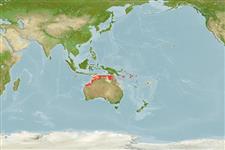इलाज़मौबरांकी (शारक और रेज़) (sharks and rays) >
Carcharhiniformes (Ground sharks) >
Atelomycteridae (Coloured catsharks)
Etymology: Atelomycterus: ateles (Gr.), imperfect, unfilled or exempt; mycteros (Gr.), nostril, referring to lack of posterior nasal valve. (See ETYFish); fasciatus: Latin for banded, referring to slender, brown saddles on a white background. (See ETYFish).
Environment: milieu / climate zone / depth range / distribution range
पारिस्थितिकी
समुद्री ड़िमरसल; गहराई सीमा 27 - 122 m (Ref. 11146), usually ? - 60 m (Ref. 11146). Tropical; 10°S - 21°S
Indo-West Pacific: northern Australia. Western Australian specimens lack the white spots and are lighter colored.
Length at first maturity / आकार / वज़न / Age
Maturity: Lm 34.5, range 30 - 39 cm
Max length : 45.0 cm TL पुल्लिंग / अलिंग; (Ref. 11146)
Short description
आकृति विज्ञान | मौरफोमैटरिक्स
पृष्ठीय रीढ़ (सम्पूर्ण): 0; पृष्ठीय सौफट रेज़ (सम्पूर्ण): 0; गुदा कांटा 0; ऐनल सौफट रेज़: 0. Black spots and markings relatively few, small, and scattered, color pattern dominated by greyish saddles and bands on light background (Ref. 11146). Western Australian specimens lack the white spots and are lighter in color (Ref. 11146).
A common offshore catshark found on mud, sand, or shelly-sand bottom (Ref. 11146). Oviparous (Ref. 50449).
Life cycle and mating behavior
परिपक्व अवधि | पुनरुत्पत्ति | मछलीऔ का अंडे देना | अंडे | Fecundity | लार्वा
Oviparous, paired eggs are laid. Embryos feed solely on yolk (Ref. 50449).
Compagno, L.J.V. and V.H. Niem, 1998. Scyliorhinidae. Catsharks. p. 1279-1292. In K.E. Carpenter and V.H. Niem (eds.) FAO Identification Guide for Fishery Purposes. The Living Marine Resources of the Western Central Pacific. FAO, Rome. (Ref. 11146)
IUCN Red List Status (Ref. 130435)
Threat to humans
Harmless
Human uses
अधिक जानकारी
Age/Sizeबाढ़Length-weightLength-lengthLength-frequenciesमौरफोमैटरिक्सआकृति विज्ञानलार्वालारवल गतिकीभर्तीबहुतायतBRUVS
संदर्भजलीयकृषिजलीयकृषि रूपरेखाखींचआनुवंशिकीElectrophoresesहैरेटिबिलटीबीमारीप्रक्रमणNutrientsMass conversion
सहयोगीयोतस्वीरेStamps, Coins Misc.ध्वनिसिगुयटिरारफ्तारतैरने के प्रकारगिल क्षेत्रOtolithsदिमागदृष्टि
साधन
Special reports
Download XML
इंटरनेट स्रोत
Estimates based on models
Preferred temperature (Ref.
123201): 25.3 - 28.3, mean 26.6 °C (based on 22 cells).
Phylogenetic diversity index (Ref.
82804): PD
50 = 0.5156 [Uniqueness, from 0.5 = low to 2.0 = high].
Trophic level (Ref.
69278): 3.7 ±0.3 se; based on size and trophs of closest relatives
लौटाव (Ref.
120179): निम्न, न्यूनतम जनसंख्या दुगनी होने का समय 4.5 - 14 वर्ष। (Fec assumed to be <100).
Fishing Vulnerability (Ref.
59153): Low to moderate vulnerability (35 of 100).
